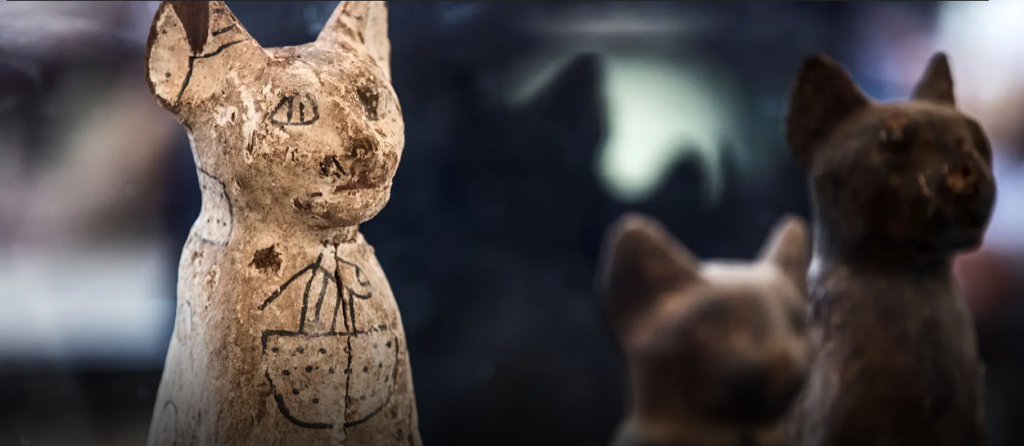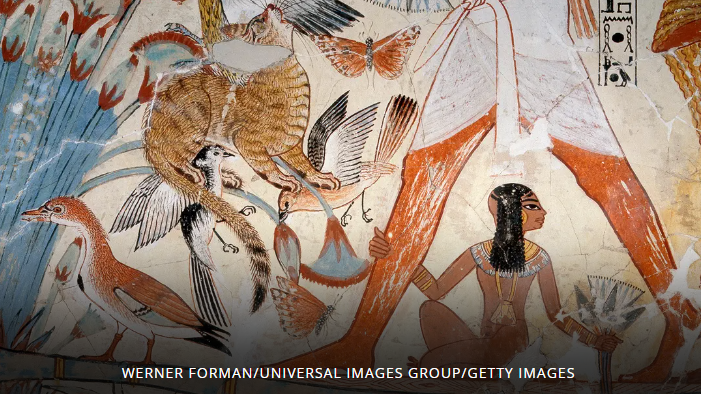How Cats Became Divine Symbols in Ancient Egypt
Felines served a useful purpose in ancient Egyptian households and were eventually associated with deities.

Along with hieroglyphics, obelisks and geometric patterns, cats feature prominently in ancient Egyptian art, reflecting the animal’s unique status among the people who dwelled along the Nile River. The animals were initially adopted as useful predators in ancient Egypt and gradually became symbols of divinity and protection.
“Though it is hard to say the Egyptians thought one thing or another, since so much change happened across their 3,000+ years of history, the ancient Egyptians, in general, did not worship animals,” says Julia Troche, an Egyptologist, assistant professor of history at Missouri State University, and author of Death, Power, and Apotheosis in Ancient Egypt: The Old and Middle Kingdoms. “Rather, [they] saw animals as representations of divine aspects of their gods.”
Whether or not they were worshiped as deities, cats were an integral part of ancient Egyptian life. And, based on mummified cats discovered in tombs alongside humans, they carried an important role in the afterlife, as well.
Cats Provided Companionship and Pest Control
For most of the civilization’s history, ancient Egyptians saw cats as mutually beneficial companions, according to Troche. “Cats might come inside when it was hot, and they in turn would chase away dangerous animals, such as snakes—many of which were venomous—and scorpions,” she explains.
Some of what we know about the function of cats in ancient Egyptian society comes from scenes of everyday life depicted in paintings on the walls of tombs. “In tombs scenes, cats are shown laying or sitting below chairs, chasing birds and playing,” Troche says. “In some mortuary texts, they are shown with a dagger, cutting through Apopis: the snake deity who threatens Ra (the sun) at night in the Underworld.”
Companionship in the Afterlife

After keeping a cat as a live-in pet during their lives, ancient Egyptians continued that relationship into the afterlife. “The tomb was one’s posthumous house for eternity,” Troche explains. “In your tombs, you would depict your family, your greatest titles and awards and the things you enjoyed doing. So, to see cats included in these tableaus speaks to their importance both in the daily lives of ancient Egyptians and in their hope that they continued with them into the Hereafter.”
On walls from the Tomb of Nebamun, now housed at the British Museum, one painting features a cat accompanying Nebamun while he is out fishing and fowling. The cat has caught a bird in its mouth and grasps two other birds in its claws. One of the eyes of the cat is embellished with gold leaf gilding, which, according to the British Museum, is “the only known example of gilding on wall paintings in Theban tomb chapels.”
The presence of cats in tombs wasn’t limited to paintings—sometimes cats were mummified and placed inside their human companion’s tomb, according to the Carnegie Museum of Natural History. One reason this was done is that when cats were mummified, they could then be used as funerary goods. “This meant that the deceased person could inhabit the body of the mummified cat in the afterlife,” explains Monique Skidmore, a professor of anthropology at Deakin University and editor of Trip Anthropologist.
Ancient Royals Made Cats Trendy
As is the case across various civilizations and cultures, ancient Egyptians saw royals as trendsetters, taking cues from the ruling tastemakers on everything from food, to fashion, to felines.
“Ancient Egyptians held cats in such high regard because of the practices and preferences of their gods, but also because their kings, the pharaohs, kept giant cats,” Skidmore says. “Members of the Egyptian royal class dressed their cats in gold and let them eat from their plates.” Although members of the lower classes weren’t in a position to dress their cats in precious metals, she notes that they did make and wear their own jewelry featuring feline designs.
And while cats were a favorite of the pharaohs, some of their characteristics were more important during some dynastic eras than others, Skidmore explains. “Bastet, for example—the daughter of the gods Ra and Isis—was first depicted as a fierce lioness, but later as a domestic cat: a dutiful mother with several kittens, and a protector of the family,” she adds.
Cats Had Coveted Characteristics

In addition to appreciating their ability to keep rodents, snakes and other pests out of their homes, the ancient Egyptians understood that cats of all sizes are smart, quick and powerful.
“Sekhmet was a lioness goddess who was a warrior and protector deity who kept at bay the enemies of the sun god Ra (also spelled “Re”) and who also kept away illness and sickness,” Troche notes. “In this way, we can see that the ancient Egyptians thought of cats, more generally, as protectors, while at the same time they respected their ferocity.”
Cats in ancient Egypt were also seen as possessing another type of power: fertility. “They are often depicted sitting under women’s chairs, implying a connection to women, and perhaps fertility more broadly,” Troche says, noting that the association may stem from the fact that cats have multiple kittens in a litter.
Cat Mummification
The ancient Egyptians believed that their gods could assume different forms, and over the centuries, it became increasingly common for gods to take the form of animals, including cats.
“These gods could not just appear with the head of a cat, for example, but could also inhabit the bodies of cats,” Skidmore explains. “That’s why cats were mummified, and a whole economy around breeding and mummifying cats was created in ancient Egypt.” In fact, the killing of cats was forbidden in ancient Egypt with one exception: mummification.
“Cats were not worshipped as gods themselves, but as vessels that the gods chose to inhabit, and whose likeness gods chose to adopt,” Skidmore explains. Through their ubiquitous presence in the art, fashion and home ornamentation of ancient Egypt, cats served as an everyday reminder of the power of the gods.
